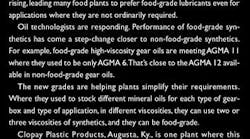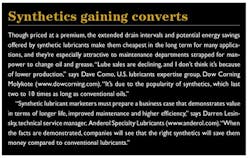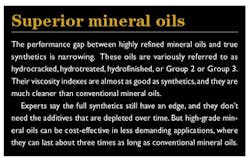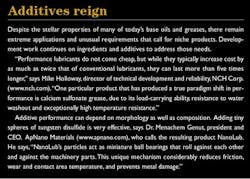"Lubrication is the lifeblood of rotating components," says Ralph Whitley, director of engineering, Boston Gear http://www.bostongear.com, "but it is one of the most overlooked and typically misunderstood failure modes."
|
View more lubricant content on PlantServics.com |
Recent economic pressures have exacerbated the problem. Many plants are stretching equipment service lives while pinching maintenance resources and pressuring purchasing departments to seek the lowest prices at any cost. "Supply-chain optimization has resulted in many plants being forced to use the cheapest lubricants accompanied by severely limited services," says Eric Bevevino, business unit manager, industrial and integrated solutions, ChevronTexaco Global Lubricants http://www.chevrontexaco.com.
The resulting brain and manpower drain has left many facilities with little expertise in or emphasis on lubrication, and even many of the best are not pursuing better practices. "They need to get from straight preventive and predictive practices to reliability-centered maintenance [RCM]," Bevevino says. "Now that supply chain has run its course, that's where the next big savings will come from."
In this environment, careful, comprehensive attention to lubrication is raising reliability and lowering costs, giving some plants a competitive edge.
"The focus is on reliability," says Al Kastonek, predictive maintenance manager, Keewatin Taconite, Keewatin, Minn. "If you're not doing that, then what are you doing? What's the alternative?"
Reliability gets attention
Methods for improving reliability range from hand-written records to the latest predictive technologies, but the key trend is actually doing it. At the high end, more plants are making reliability a job or department function, supported with training, software and authority.
An effective reliability engineering department includes "a cross-trained group of highly skilled technicians whose main focus and function is to keep equipment running at optimal performance continuously," says Mike Holloway, director of technical development and reliability, NCH Corp. http://www.nch.com. Its RCM program uses both predictive maintenance (monitoring vibration, temperature, alignment, wear debris, oil analysis, etc.) and proactive maintenance: monitoring and correcting failing parts, identifying root causes and setting up corrective action plans.
Holloway says the best implementations are taking full advantage of equipment maintenance management software to "not only generate and schedule work orders, but to track equipment repair costs and identify failure modes."
Most plants are still far short. "If they have world-class practices, they have a fairly comprehensive oil analysis program," says Dave Como, U.S. lubricants expertise group, Dow Corning Molykote http://www.dowcorning.com. "Progress will come when they actually take that data -- take that software -- and put it to use. Perhaps 30% are doing that. A lot of them are taking the samples, then changing the oil every six weeks."
Keeping it clean
As a lubricant expert for a tribology company in a former life, Noyan Ercan, reliability engineer for the Shell Co. of Australia http://www.shell.com.au, learned, "You can buy the most expensive lubricants, but if you don't keep them clean, it's all for naught."
But it was the third-shift catastrophic failure of a forced-draft fan that made him a crusader against poor storage and dispensing practices. The fan bearing housing had been topped up using a common metal oil container kept near the blower for that purpose. A post-mortem investigation found the oil in the container included about 50% water. Water in the bearing led to loss of lubrication, metal-to-metal contact, and destruction of the motor as well as the bearing, shaft and seal.
Conventional drums and top-up cans breathe with changes in temperature, collecting condensed steam, rainwater and airborne contaminants, Ercan says. They end up containing a mixture of oil, water, dust and dirt. "Even sealed drums breathe through the bung threads and collect water over time," he says. "You can have a brand-new drum and if it's been sitting around, when you open it and shine a flashlight in, you can see water at the bottom."
Water can also enter equipment directly through seals, vents or breathers. It may come from humidity, rain, temperature changes, steam quenching or washdown. "Humidity sensors can measure the amount of water vapor present in the lubricating oil," says Rojean Thomas, manager of engineering, Trico Mfg. http://www.tricomfg.com. A sensor can be submerged in the oil or mounted above it to measure the relative humidity in the headspace.
On-site filtration by third-party suppliers can maximize the life of high-quality lubricants, says Bevevino. "Attention to system cleanliness through the use of desiccant breathers and new fill-containers designed to prevent contamination are also emerging trends," he adds.
Gearbox makers and breathing device suppliers are responding. "Emerging technologies such as Boston Gear's PosiVent gear box resist contaminants getting into the housing and ultimately the oil sump by filtering them with a closed pressure equalization system," Whitley says.
Well-designed oil-changing equipment helps Clopay Plastic Products, Augusta, Ky., keep equipment in service and lubricants off the floor. "Changing oil on our largest gearboxes used to take about 2 1 2 hours and make a mess," says Scotty Lippert, Clopay planned maintenance technician. "With oil-changing equipment, it takes 10 to 12 minutes and we never expose the oil to the atmosphere."
At Keewatin Taconite, pervasive taconite grit makes ordinary dust and water seem trivial. "We have a lot of slow-moving equipment and a lot of Taconite dust, which is a form of silica," Kastonek says. "It's everywhere and it's very abrasive. Contamination is a big, big deal." The plant has converted to extended-life synthetic lubricants to minimize opening the gearboxes. Bearing isolators keep Taconite out and prevent leaks that can lead to topping up under uncontrolled conditions. Kastonek says, "There's no substitute for oil cleanliness."
As Lippert puts it, "Contamination control is critical. Even the smallest particle will start a pit in a gear."
Not making mistakes
For such a conceptually simple function, industrial lubrication is fraught with potential for small errors to cost big bucks. Contamination is just one example. Here are some of the other problems experts say the best plants are addressing:
* Lack of process: Plants that have thousands of moving parts have unique lubrication requirements and schedules that are difficult to meet and track. This leads to mistakes and oversights such as empty oil reservoirs or grease fittings overlooked due to lack of proper documentation. Como warns, "If it is difficult to find, it will be even more difficult to repair."
* Unclear or multiple choices of lubricants: The wrong lube can damage equipment, causing preventable maintenance and increased downtime. "Suppliers offering only a limited line of lubricants sometimes try to force-fit their products regardless of specific application requirements," Como says. "As a result, lubricants over- or under-engineered for a given application can cost machine life and maintenance dollars."
* Leaks: "Fix the seals so you don't have the off shifts adding oil," Kastonek says. "That's when things burn up."
* Poorly identified equipment and supplies: Ercan now keeps lubricants in dedicated, color-coded locations and containers. He says, "We have reduced our requirements to mainly three or four different types of lubricants, and now we have color-coded charts posted throughout the plant for quick reference."
* Unfamiliar equipment: "Equipment manufacturers are constantly updating technologies to improve overall performance and reliability," says Darren Lesinski, technical service manager, Anderol Specialty Lubricants http://www.anderol.com. "And in many cases, synthetics are required to allow the equipment manufacturers to implement these technology advances."
* Lack of ownership: "We had operations doing the maintenance, so it was a low priority for them compared to production," Ercan says. "And we had no control over what they did on off shifts." Make lubrication somebody's primary responsibility, he says. "If there's no ownership, you're risking your business."
The critical path
The problems of industrial lubrication can be daunting for the maintenance practitioner bent on improving operations. "It's not easy because the maintenance and even purchasing departments are two or three levels below the decision-makers on big-money maintenance and reliability programs," Bevevino says. "You have to be an advocate -- a champion."
The first step is to define a program. "With the manpower cuts that are so common, you may have to do some overtime," Kastonek says. "Figure out when and how, and do it."
Clopay started with a lube survey that included "every zerk fitting, every gearbox," Lippert says. "We documented and color-coded them, and marked them with which and how much lubricant."
Computerized maintenance management systems (CMMS) can be a large part of a plant's RCM program, or not. "Though hundreds of thousands of dollars are spent on state-of-the-art systems, most are severely underutilized and ineffective," Bevevino says. "Databases have been developed by ChevronTexaco Alliance partners to get CMMS systems up, running and deployable in a much more effective and rapid fashion than in-house development. This can propel its users into the high-return-on-CMMS-investment zone before their competition, and it's the key to getting through the RCM transition. It is the new trend that industrial maintenance folks are beginning to realize."
But don't let your CMMS situation hold you back. At Keewatin Taconite, the reliability group works with the various maintenance departments to be sure things are designed, aligned and balanced properly. They make sure equipment is sampled and oil is changed regularly.
Maintenance relies on oil and vibration analysis, and input from the reliability group. "We look at every single bearing, every coupling," Kastonek says. The plant has CMMS and EAM software, but a lot of the communication is done with checksheets in Word and Excel, prepared on a weekly and monthly basis. "There's no computer that can follow up, talk with someone and find out if it got done," he says. "No computer can close a work order."
Training can be a very powerful motivator, and is available for every level, from lube tech to reliability or plant engineer. Sources range from NORIA http://www.noria.com to the Society for Maintenance and Reliability Professionals (SMRP) http://www.smrp.org to the International Council for Machinery Lubrication (ICML) http://www.lubecouncil.org to your favorite oil company.
Training helps promulgate best practices among technicians and transfer knowledge from older, more experienced technicians to younger workers. "If they go to these training or seminar activities, they can hear the questions from their peers, which helps make the training more useful and real," says Steve Clements, industrial product offer adviser for the Americas, ExxonMobil http://www.exxonmobil.com.
Bevevino feels strongly that every plant should have access to competent consulting through their lubricant supplier. "Look for a major oil company that's focused on being a partner with the plant," he says. "Get involved with the SMRP. Gain acumen and implement a small project. Show success to gain credibility with higher-ups.
"People aren't doing the wrong thing on purpose -- they just don't know. We have had plants that cut maintenance personnel from 200 to 80 call and ask, 'How can you help us?' That's great, but it's not so great when the door opens after it's too late, when they're already on the road to bankruptcy."





